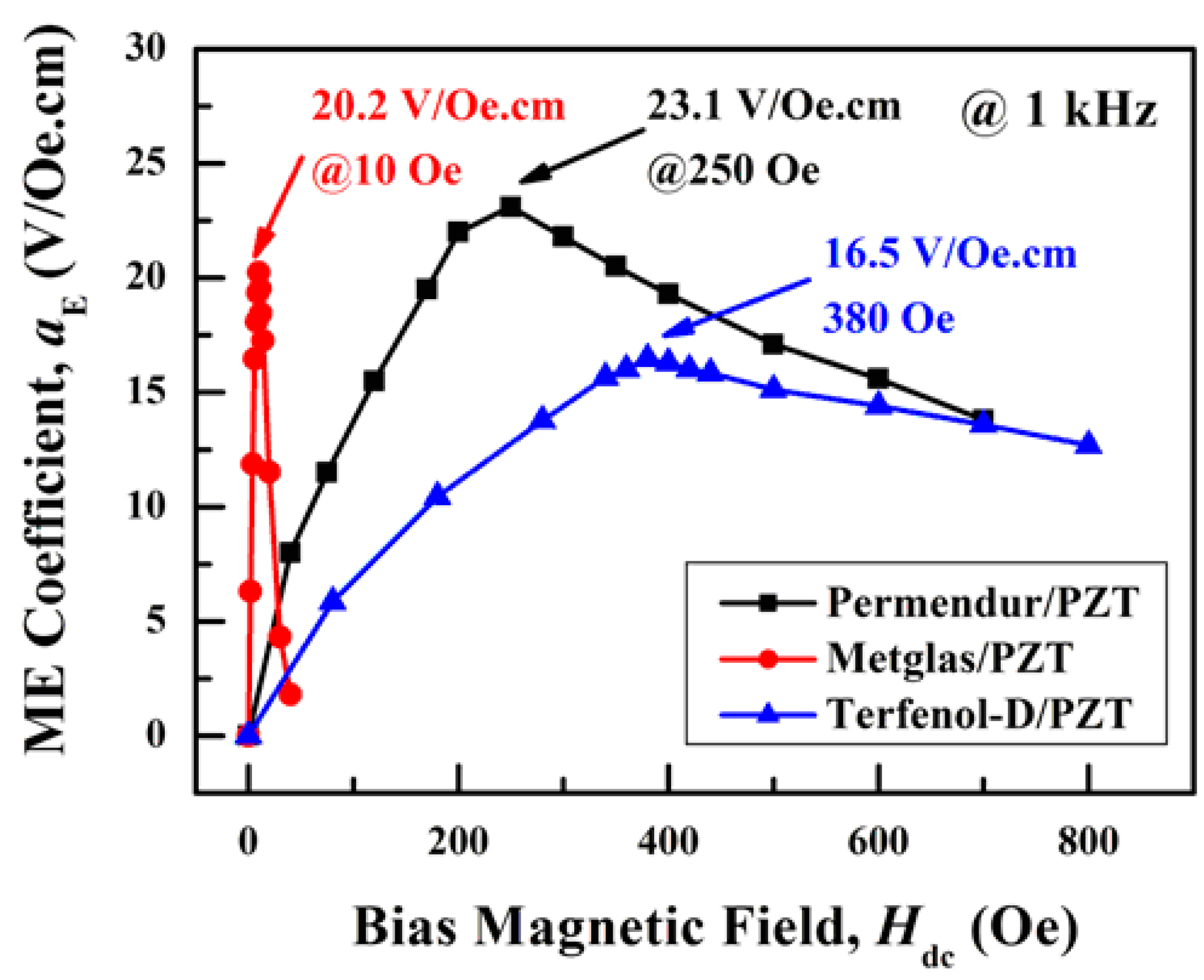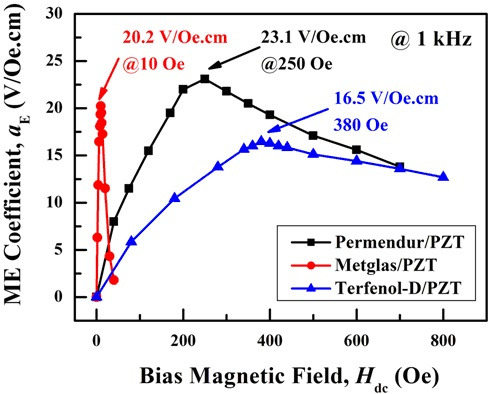Enhanced Magnetoelectric Effect in Permendur/Pb(Zr0.52Ti0.48)O3 Laminated Magnetostrictive/Piezoelectric Composite
Abstract
:1. Introduction
2. Experimental Section
3. Results and Discussion
| Title | (ppm) | (Oe) | (T−1) | |||
|---|---|---|---|---|---|---|
| Terfenol-D | 2000 (+) | 10 (−) | 400 (Medium) | 9.5 × 10−4 | 110 | 2 × 104 |
| Metglas | 20 (−) | 5000 (+) | 10 (−) | 7.5 × 10−5 | 2450 | 1 × 105 |
| Permendur | 100 (+) | 5000 (+) | 250 (Medium) | 7.8 × 10−5 | 2450 | 5 × 105 |




4. Conclusions
Acknowledgments
Author Contributions
Conflicts of Interest
References
- Wu, Z.; Xiang, Z.H.; Jia, Y.M.; Zhang, Y.H.; Luo, H.S. Electrical impedance dependence on the direct and converse magnetoelectric resonances in magnetostrictive/piezoelectric laminated composites. J. Appl. Phys. 2012, 112, 106102. [Google Scholar] [CrossRef]
- Wang, Y.J.; Zhao, X.Y.; Jiao, J.; Liu, L.H.; Di, W.N.; Luo, H.S.; Or, S.W. Electrical resistance load effect on magnetoelectric coupling of magnetostrictive/piezoelectric laminated composite. J. Alloys Compd. 2010, 500, 224–226. [Google Scholar] [CrossRef]
- Jia, Y.M.; Luo, H.S.; Or, S.W.; Wang, Y.J.; Chan, H.L.W. Magnetoelectric and converse magnetoelectric responses in TbxDy1−xFe2−y alloy & Pb(Mg1/3Nb2/3)(1−x)TixO3 crystal laminated composites. Chin. Sci. Bull. 2008, 53, 2129. [Google Scholar] [CrossRef]
- Wang, Y.J.; Leung, C.M.; Or, S.W.; Zhao, X.Y.; Luo, H.S. Resonance converse magnetoelectric effect in a dual-mode bilayered composite of Pb(Mg1/3Nb2/3)O3–PbTiO3 and Tb0.3Dy0.7Fe1.92. J. Alloys Compd. 2009, 487, 450–452. [Google Scholar] [CrossRef]
- Jia, Y.M.; Or, S.W.; Chan, H.L.W.; Jiao, J.; Luo, H.S.; Zwaag, S. Bidirectional current-voltage converters based on magnetostrictive/piezoelectric composites. Appl. Phys. Lett. 2009, 94, 263504. [Google Scholar] [CrossRef]
- Wang, Y.J.; Wang, F.F.; Or, S.W.; Chan, H.L.W.; Zhao, X.Y.; Luo, H.S. Giant magnetoelectric effect in mechanically clamped heterostructures of magnetostrictive alloy and piezoelectric crystal-alloy cymbal. Appl. Phys. Lett. 2008, 93, 213504. [Google Scholar] [CrossRef]
- Wang, Y.J.; Or, S.W.; Chan, H.L.W.; Zhao, X.Y.; Luo, H.S. Enhanced magnetoelectric effect in longitudinal-transverse mode Terfenol-D/Pb(Mg1/3Nb2/3)O3-PbTiO3 laminate composites with optimal crystal cut. J. Appl. Phys. 2008, 103, 124511. [Google Scholar] [CrossRef]
- Jia, Y.M.; Zhao, X.Y.; Luo, H.S.; Or, S.W.; Chan, H.L.W. Magnetoelectric effect in laminate composite of magnets/0.7Pb(Mg1/3Nb2/3)O3-0.3PbTiO3 single crystal. Appl. Phys. Lett. 2006, 88, 1–3. [Google Scholar]
- Jia, Y.M.; Luo, H.S.; Zhao, X.Y.; Wang, F.F. Giant magnetoelectric response from the combination of piezoelectric/magnetostrictive laminated composite with a piezoelectric transformer. Adv. Mater. 2008, 20, 4776–4779. [Google Scholar]
- Brown, W.F.; Hornreich, R.M.; Shtrikman, S. Upper bound on the magnetoelectric susceptibility. Phys. Rev. 1968, 168, 574–577. [Google Scholar] [CrossRef]
- Wang, Y.J.; Wang, F.F.; Or, S.W.; Chan, H.L.W.; Zhao, X.Y.; Luo, H.S. Giant sharp converse magnetoelectric effect from the combination of a piezoelectric transformer with a piezoelectric/magnetostrictive laminated composite. Appl. Phys. Lett. 2008, 93, 113503. [Google Scholar] [CrossRef]
- Wu, Z.; Zhang, J.; Ma, K.; Cao, Y.; Jia, Y.M.; Luo, H.S.; Zhang, Y.H. A magnetoelectric laminate based passive micro-displacement sensor. Phys. Status Solidi R 2012, 6, 469–471. [Google Scholar] [CrossRef]
- Guo, Y.P.; Liu, Y.; Wang, J.L.; Withers, L.R.; Chen, H.; Jin, L.; Smith, P. Giant magnetodielectric effect in 0–3 Ni0.5Zn0.5Fe2O4-Poly(vinylidene-fluoride) nanocomposite films. J. Phys. Chem. C 2010, 114, 13861–13866. [Google Scholar] [CrossRef]
- Wang, Y.J.; Gray, D.; Berry, D.; Li, M.H.; Gao, J.Q.; Li, J.F.; Viehland, D. Influence of interfacial bonding condition on magnetoelectric properties in piezofiber/Metglas heterostructures. J. Alloys Compd. 2012, 513, 242–244. [Google Scholar] [CrossRef]
- Wang, Y.J.; Gray, D.; Berry, D.; Gao, J.Q.; Li, M.H.; Li, J.F.; Viehland, D. An extremely low equivalent magnetic noise magnetoelectric sensor. Adv. Mater. 2011, 23, 4111–4114. [Google Scholar] [CrossRef] [PubMed]
- Wang, Y.J.; Hasanyan, D.; Li, M.H.; Gao, J.Q.; Viswan, R.; Li, J.F.; Viehland, D. Electric-field tuning of magnetoelectric properties in Metglas/piezofiber composites. Phys. Status Solidi R 2012, 6, 265–267. [Google Scholar] [CrossRef]
- Wang, Y.J.; Shen, Y.; Gao, J.Q.; Li, M.H.; Li, J.F.; Viehland, D. Nonlinear magnetoelectric response of a Metglas/piezofiber laminate to a high-frequency bipolar AC magnetic field. Appl. Phys. Lett. 2013, 102, 102905. [Google Scholar] [CrossRef]
- Rees, D.W.; Gibbs, M.R.J.; Pace, N.G. The use of metallic glass scroll as an acoustic transducer element. IEEE Trans. Ultrason. Ferroelect. Freq. Control 1989, 36, 332–336. [Google Scholar] [CrossRef] [PubMed]
- Jia, Y.M.; Or, S.W.; Wang, J.; Chan, H.L.W.; Zhao, X.Y.; Luo, H.S. High magnetoelectric effect in laminated composites of magnetostrictive alloy and lead-free piezoelectric ceramic. J. Appl. Phys. 2007, 101, 1–5. [Google Scholar] [CrossRef]
- Sourmail, T. Near equiatomic FeCo alloys: Constitution, mechanical and magnetic properties. Prog. Mater. Sci. 2005, 50, 816–880. [Google Scholar] [CrossRef]
- Matsumoto, M.; Kubota, T.; Yokoyama, M.; Okazak, T.; Furuya, Y.; Makino, A.; Shimada, M. Magnetic properties of rapidly solidified ribbon of Fe49Co49V2 and spark-plasma-sintered pellet of its powder. Mater. Trans. 2010, 51, 1883–1886. [Google Scholar] [CrossRef]
- Wang, Y.J.; Or, S.W.; Chan, H.L.W.; Zhao, X.Y.; Luo, H.S.; Lv, X.K.; Zhang, Z.D. Magnetoelectric effect in laminates of polymer-based pseudo-1–3 (Tb0.3Dy0.7)0.5Pr0.5Fe1.55 composite and 0.3Pb(Mg1/3Nb2/3)O3-0.7PbTiO3 single crystal. Appl. Phys. A 2009, 97, 201–204. [Google Scholar] [CrossRef]
- Or, S.W.; Cai, N. Dielectric, magnetic and magnetoelectric prop erties of a laminated composite with 1-3 connection. Solid State Phenom. 2006, 111, 147–150. [Google Scholar] [CrossRef]
- Wu, Z.; Tian, X.L.; Jia, Y.M.; Tian, X.J.; Xie, A.X.; Zhang, Y.H.; Luo, H.S. Giant magneto-light output in three-phase magnetostrictive, piezoelectric and electroluminescent composites. Appl. Phys. Lett. 2011, 99, 212503. [Google Scholar] [CrossRef]
- Wu, Z.; Ma, K.; Cao, Y.; Jia, Y.M.; Xie, A.X.; Chen, J.R.; Zhang, Y.H.; Li, H.M.; Zheng, R.K.; Luo, H.S. Strong secondary piezoelectric effect in ferroelectric 0.7Pb(Mg1/3Nb2/3)O3-0.3PbTiO3 crystal. Appl. Phys. Lett. 2013, 103, 112904. [Google Scholar] [CrossRef]
© 2015 by the authors; licensee MDPI, Basel, Switzerland. This article is an open access article distributed under the terms and conditions of the Creative Commons Attribution license (http://creativecommons.org/licenses/by/4.0/).
Share and Cite
Jia, Y.; Zhou, W.; Ma, K.; Liu, Y. Enhanced Magnetoelectric Effect in Permendur/Pb(Zr0.52Ti0.48)O3 Laminated Magnetostrictive/Piezoelectric Composite. Appl. Sci. 2015, 5, 587-594. https://doi.org/10.3390/app5030587
Jia Y, Zhou W, Ma K, Liu Y. Enhanced Magnetoelectric Effect in Permendur/Pb(Zr0.52Ti0.48)O3 Laminated Magnetostrictive/Piezoelectric Composite. Applied Sciences. 2015; 5(3):587-594. https://doi.org/10.3390/app5030587
Chicago/Turabian StyleJia, Yanmin, Wenjing Zhou, Ke Ma, and Yongsheng Liu. 2015. "Enhanced Magnetoelectric Effect in Permendur/Pb(Zr0.52Ti0.48)O3 Laminated Magnetostrictive/Piezoelectric Composite" Applied Sciences 5, no. 3: 587-594. https://doi.org/10.3390/app5030587






